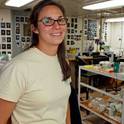
Presentation
Larval development and feeding in two species of an abundant snail at hydrothermal vents on the Mariana Arc and Back-Arc system
6th International Symposium on Chemosynthesis-Based Ecosystems
(2017)
Abstract
Shinkailepas species are limpet-like marine snails that live at hydrothermal vents along arc/back-arc systems in the Western Pacific. Adult snails lay numerous egg capsules that hatch into planktonic larvae that are presumed to be planktotrophic. Here, we describe the temperature tolerances of developing embryos of two Shinkailepas species and larval temperature tolerances and food preferences of one species. Egg capsules were collected from two seamounts along the Mariana Arc: Shinkailepas n. sp. 1 from NW Rota-1 (depth 500 m) and Shinkailepas n. sp. 2 from NW Eifuku (depth 1200 m). Temperatures at these sites range from 2-30°C. We examined embryonic and larval survival at temperatures of 6°C, 15°C and 25 °C over several weeks. There was no significant effect of temperature on survival probability or probability of hatching for either species. Survival of hatched larvae of Shinkailepas n. sp. 1 was negatively affected by high temperature, but larval survival at 6 °C was high even when embryonic development was at the highest temperature. Grazing experiments with larvae of Shinkailepas n. sp. 1 showed no significant consumption of microalgae or the cyanobacteria Synechococcus. Additionally, Shinkailepas n. sp. 1 larvae survived at 6 °C in the lab up to 90 days without food, had large visible lipid stores, maintained a steady metabolic rate over time, and did not appear to grow. However, epifluorescence imagery of the gut indicated that larvae might eat small amounts of Synechococcus. This suggests that Shinkailepas n. sp. larvae may eat cyanobacteria or other picoplankton opportunistically, but can live without feeding for extended periods of time supported by their lipid stores.
Keywords
- Larval development,
- Hydrothermal vents,
- Shinkailepas
Disciplines
Publication Date
August, 2017
Location
Woods Hole, MA
Citation Information
Shawn M. Arellano, Chelsea Collins and Jacob T. Krodel. "Larval development and feeding in two species of an abundant snail at hydrothermal vents on the Mariana Arc and Back-Arc system" 6th International Symposium on Chemosynthesis-Based Ecosystems (2017) Available at: http://works.bepress.com/shawn-arellano/28/
